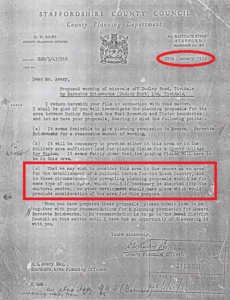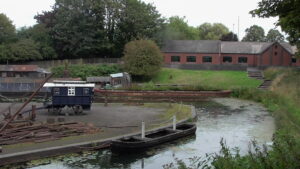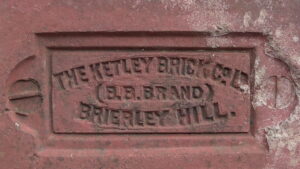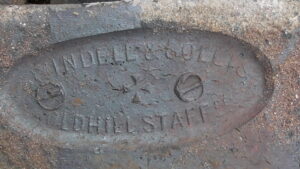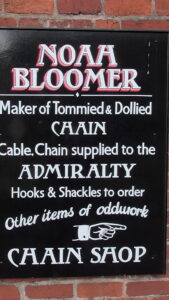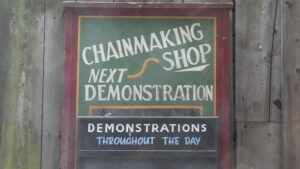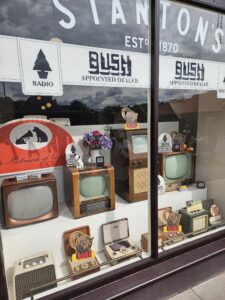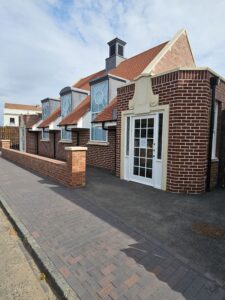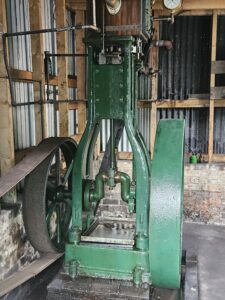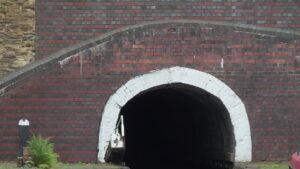This site is one of the most well known tourist attractions in the region and offers a fascinating window into the soul of an area that has since perhaps lost its identity. I say this obviously because of the decline of industry, but also feel that there are well meaning people who wish to keep alive the spirit of the “black country” but end up becoming ridiculous caricatures, putting on forced dialects of how they believe that people spoke in the area and then reverting privately to posher tones when out of earshot.
I discovered by accident through old planning records from the 1950’s that this site may well have been built elsewhere, and on the doorstep of Rattlechain Lagoon itself! A letter from Staffordshire County Council concerning one of the most important planning applications (216), concerning the former brickworks spoke of the potential establishment of a “Black country cultural centre” being built on the extensive open land in a post war development. Unfortunately however the conman Sheldon got his way and the fake brickworks operation continued with a pit dug that would become an industrial waste filling zone, and then a foundry sand dump “supporting” housing and swingers pampus grass “private open space” 😆 .
What a missed opportunity, and in some parallel universe where Jersey tax evasion and hiring someone to burn down historic buildings doesn’t exist, we may have seen a preserved old rattlechain brickworks operation , a restored canal basin that The Barnetts would have known and a canal museum quarter. Alas, instead we got wall to wall houses and toxic waste dumps instead, and Albright and Wilson continuing their shit tipping into the old marlhole. 😥
The current site in this universe was established much later , in 1978. Sandwell’s loss was to be Dudley’s gain. I’ve visited this site twice before when it was just known as “The Black Country Museum”. The first time I must have been about eight, and I remember it being an uncomfortably hot day, and at that time bored shitless about all around me. The canal boat trip was the most memorable part. It would be some time later for a second visit, this time as part of a school project about old kitchens. This time I was more studious and alert to my historic surroundings, and felt more of a connection with the environment. This was around thirty years ago.
What then had become of this site and the new additions that made it a “living” museum?
My first impressions, and that which remain after this excursion is that it didn’t feel like a “living” museum, instead more like looking back through a window or room left vacant. The odd clanking sound playing in the background doesn’t bring anything to life at all, more like a “don’t touch” postcard with sound effects. There should be opportunities for touching old objects and learning what they were used for through interactive devices. Other sites I have visited, such as the museum at Silverstone and also the Aerospace museum in Bristol employ such MacGuffins to good use.
My favourite vista at the site remains the canal side ensemble. A number of historic boats are present.
I also was on the hunt for old stamped bricks, and found a few new names that I had not seen before on my travels along the canals of the area, though alas, no holy grail, Barnett rattlechain blue bricks.
I was surprised however to see Hannibal Lecter lying around conspicuously in a pile. I wonder where he came from?

One very disappointing aspect was the fact that there were no visible demonstrations of any of the crafts and trades that made this museum. On my previous visits, I very much recall that this being one of the highlights. I remember people being taught and then being able to blow glass and keep the rubbish distortions they made, as well as how chains were made and forged.
When we went there were no chain makers in sight. Perhaps it is not woke anymore to make them, or maybe they were having a chain makers strike. 🙂
Indeed, the people dressed up in old clothes were more like Poundland Cosplayers than active participants or guides, and may as well not have even been there. This is different to say the experience at Blackpool’s Tower Dungeon where actors although pantomime get into the roles and bring the experience to life by winding up and talking to people as they experience the rides and special effects. We could for example see a 19th Century black country family gathering sitting down to dinner and how hard that might have been. We could see a crystal maze type experience where people have to solve puzzles being guided by black country characters and trying to evade a villain.
How about a talking heads style story monologue of a day in the life of a black country housewife, a child in service, a schoolteacher, a boatman, a miner trapped underground believing that his fate was sealed, or any of the other types of trade at the museum which would bring the action to life, even if they are presented as ghosts of the past? What did they do, how did they live, what are their memories, and even how did it end for them? The characters could even connect to tell a wider story.
There could be a police station where people are locked up and booked in. A fire brigade demonstration. These are just some ideas off the top of my head, but it would be better than the current wander as you go vacancy.
I was also struck by the too close proximity of the new 40/50’s zone to the older 19th Century areas, which appear to be like walking off one filmset and onto another. It looks like this is going to be an English homage at Back to The Future but on a less grand scale. A post office, television shop and building society are already there, with more to come this Autumn.
This unfortunately is where I see this museum starting to unravel into “wokeycokey” land, where the history of the area itself starts to be replaced and eroded instead by the contemporary history of the people who made it their home many decades later. The area does not need a flag, and nor does this need to be a sale item- it never existed in the time itself and serves as a latter day invention, usually being touted by some politician for self promotion pretending to be interested in the area on a named “black country day”!
There are other museums and exhibitions dedicated with lottery funding to immigration and culture, but this is not a place that should be celebrating that. There is no getting away from the fact that this area was forged by its white working class, and the hammers that banged on metal would be white phallus shaped implements, the women women and the men men.
The proprietors of this museum should not attempt “inclusiveness” and wokery to reach out to a different audience. They should not apologise for chain- making or anything else due to it no longer being politically correct. Any attempt to do that is to erase the history of the area which made it, for good or for bad.
It was Mr Smith and Mr Jones that went down the pits and not Mssrs Singh and Khan. The black country was made so by black and white and red all over scenes, and not by rainbow flags. Equally, it was a time when Arthur knew his purpose in life and so did Martha, and they didn’t require gender identification symbols, badges or pronouns as they all used the same brick shithouse. 🙂
Just to say, that as I have written elsewhere on this website, I have a big problem with the white Victorian industrialists being praised for their “generosity” and fake philanthropy. The people who lived in poverty did so holding a false awe about the upstairs class, including the absolutely pointless figurehead at the heart of the evil Empire, the fat old bitch herself. Her remarks about wanting to avoid the area do not support her place on any mantlepiece within it, though inadvertently, she probably named the region itself, and perhaps condemned it with that name thereafter forever more.
The other problem with this site is that the popular tours and attractions- the mine trip, the fish and chip shop experience and the canal tour, now run externally by The Dudley Canal Trust are heavily populated and you would be queuing for a very long time to get anywhere. This needs to be sorted out by bookings in the case of the mines.
The anachronisms of different eras unpartitioned also give the impression that this site wants to be used as a film and television studio. Maybe that is how it will make money to expand, but this also means that it will become less “black country” and more Hollywood in the form of garbage like Peaky Blinders. Such distortions and fake history like this show may well bring in the punters who clamour for wearing flat caps and neckerchiefs like their fictional anti-heroes but this doesn’t honour the black country, and was never a part of its cultural identity at all. Unfortunately most of the items for sale in the gift shop are advertisements for this BBC show. 😥
I was also very dismayed to see amongst the substantial collection of books and booklets ones concerning the terrorist and fake women’s vote winner Emmeline Pankhurst. This is another example of where elite political class history has been written by those wishing to portray the version that it wants and not the real version of events. She has no connection to this area at all and it is difficult to see why it is included here, other than catering for some rewriting of history because the name is famous, but nonetheless one that has had greatness thrust upon them.
In conclusion, I would say that pulp fiction and modern history are replacing real history at The Black Country Living Museum. The area is not really one to “celebrate” in terms of its industrial legacy. One is reminded of real first hand accounts of the area such as the Oldbury historian F.W Hackwood in the volume Oldbury and Round About published in 1915.
He spoke of the corroding gases “emitted from chemical works in the heart of the town so completed the blight that even grass and the hardiest of plants failed not to succumb. Not by incessant labour could Oldbury housewives keep fire-irons or other utensils of bright steel in any desirable condition of cleanliness; metal tarnished in a single night, and in process of time faded away as they had been petals of a fading flower.”
Perhaps people visiting this museum should be reminded of how grateful they should be that they did not live through such times and no longer have to today.


